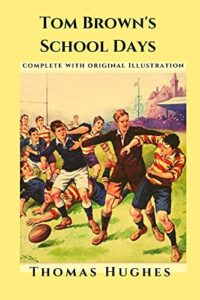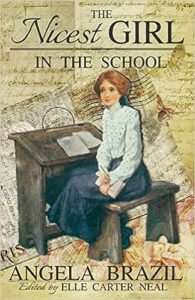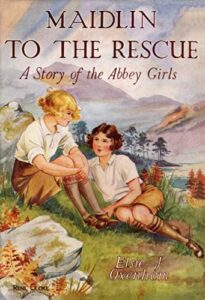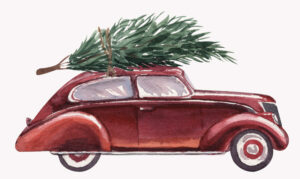About the series: In this series, we explore different creative writing genres that have captured children’s imagination over the years.
Ever found yourself daydreaming about midnight feasts in cozy dorm rooms, secret societies, or perhaps magical classes in ancient castles? You’re not alone! Dive into the enchanting realm of British boarding school stories with me!
British boarding school stories have a lineage tracing back to the mid-19th century. One of the first, and perhaps most influential, novels of this genre is Tom Brown’s Schooldays by Thomas Hughes, published in 1857. This novel provides a detailed and vivid portrayal of life at Rugby School, an all-boys boarding school in England. Hughes’ work is often considered the archetype of the genre, setting the tone for many stories that would follow.
Originally, many of these novels were moral and instructional in nature, aiming to prepare young boys (and, eventually, girls as the genre evolved) for the challenges of adult life, particularly in the British Empire. They were also tools for endorsing the values of the upper and middle classes in Britain. A sense of duty, honour, decency, and the importance of sportsmanship were common themes.

ANJALY FRANCIS
Anjaly is the founder of Common Room and a Cambridge- certified teacher of English. Her childhood goal was to read every book in the children’s section of the library. Through Common Room, she wishes to inspire and nurture young minds by providing a platform to explore and develop their writing skills, foster creativity, and ignite a love for storytelling.
In the late 19th and early 20th centuries, as girls’ education became more widespread, boarding school stories for girls emerged as a distinct subgenre. Angela Brazil, in the early 20th century, is often credited with making the girls’ boarding school story popular. Her works, like The Nicest Girl in the School (1909), often depicted more liberated and active young women than earlier novels had, and they were set in a decidedly contemporary world.
The period between the World Wars is often considered the ‘Golden Age’ of the boarding school story. Authors like Enid Blyton and Elsie J. Oxenham contributed to the genre’s growth with a plethora of stories set in boarding schools. Blyton’s Malory Towers and St Clare’s series, along with Oxenham’s Abbey series, set a template: the new girl’s arrival, the settling into dorm life, the making and breaking of friendships, and the annual cycle of the school year.
After World War II, the boarding school genre began to evolve, reflecting broader shifts in British society. The rigid class system was slowly changing, and this transformation was echoed in the genre. In the latter half of the 20th century, authors began to use the boarding school setting to explore more diverse and sometimes controversial themes, including race, class, and gender.
In the late 20th and early 21st centuries, J.K. Rowling’s Harry Potter series brought a resurgence in the popularity of the boarding school genre, reimagining it with a magical twist. The boarding school, in Rowling’s hands, became a place of wonder and danger, as well as the more traditional themes of friendship and rivalry.
Throughout its history, the British boarding school story has continued to reflect cultural and societal changes in the UK, offering a window into the evolving character and values of British life.
The Anatomy of a British Boarding School Story
These tales are characterized by their setting: elite institutions where students learn and live. The enclosed environment of the boarding school—a world unto itself—is integral to these stories. These settings—often isolated, filled with tradition, and governed by strict codes of behavior—provide ripe ground for drama and camaraderie alike. The boarding school acts as a microcosm of society, complete with its own rules and hierarchies, yet separate from the outside world.
Key Characteristics and Themes
Common threads run through these novels—themes of friendship, rivalry, personal growth, moral lessons, and the inevitable clash with authority figures. These stories often follow a young protagonist’s journey from naivety to maturity. Despite the changing world outside, these themes remain constant inside the school gates. Many of these narratives subtly critique the class and gender norms of their day, offering complex depictions of adolescence.
Iconic Works and Authors
Enid Blyton’s Malory Towers and St Clare’s series are seminal works, showcasing a quintessentially British boarding school life. J.K. Rowling’s Harry Potter series modernised and globalised the genre, infusing it with elements of fantasy. These authors have achieved international acclaim, demonstrating the genre’s capacity to transcend cultural boundaries and appeal to readers of all ages.
The Genre’s Influence on Pop Culture
From film adaptations like Dead Poets Society to satirical takes like St Trinian’s, the boarding school setting is a rich seam for storytellers. They’ve evolved from moral tales into a versatile and enduring cultural motif. These stories continue to resonate, inspiring not only book sequels but also movie franchises, television series, and stage adaptations. Movies such as Wild Child (2008) as well as the 2020 TV series titled Malory Towers and so on vouch for the continuing popularity of the genre across generations. They reflect both a fascination with and a critique of a particular slice of British life.
I am excited to launch the Genre Tapestry series by introducing the British Boarding School Story to you. It’s my absolute favourite, with teen mysteries trailing not too far behind. But that’s not all! I am also rolling out a brand-new advanced creative writing course designed specifically for young writers aged 13 to 15. Named The Midnight Feast, this course is steeped in the enchanting and nostalgic world of boarding school tales that have inspired generations of readers. Are you curious to discover more about The Midnight Feast course? Your journey into this captivating world can start today – just let me know in the comments below!”








1 thought on “Genre Tapestry I: The British Boarding School Story”
Pingback: Imagining the British Boarding School: Illustration Contest for Young Artists! – Common Room :: Creative Writing Courses for Children